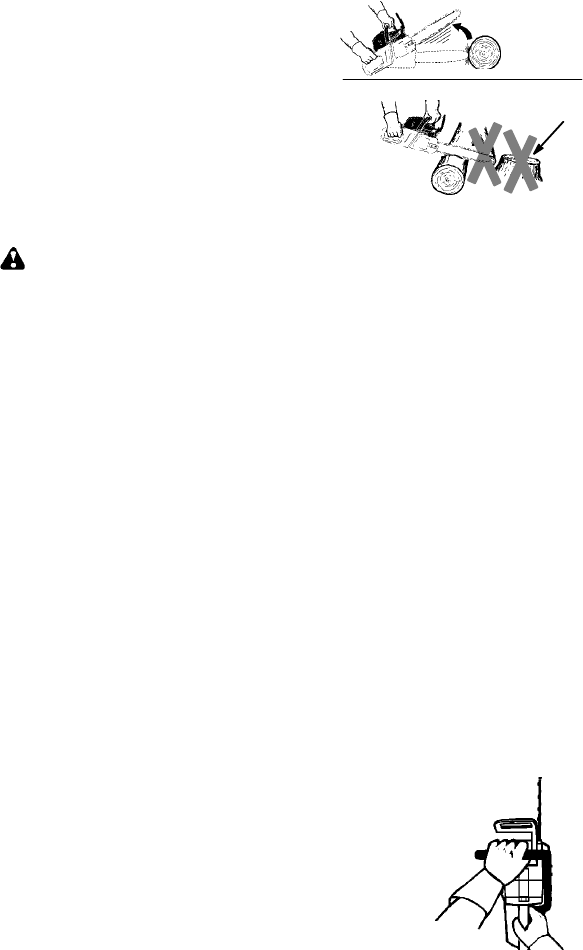
5
S Mix and pour fuel in anoutdoorarea onbare
ground; store fuel in a cool, d ry, well venti-
lated place; and use an approved, marked
container for all fuel purposes. Wipe up all
fuel spills before starting saw.
S Move at least 10 feet (3meters) fromfuel-
ing site before starting engine.
S Turn the engine off and let saw cool in a
non-combustible area, not on dry leaves,
straw, paper, etc. Slowly remove fuel cap
and refuel unit.
S Storetheunitandfuelinanareawherefuel
vapors cannot reach sparks or open
flamesfrom waterheaters, electricmotors
or switches, furnaces, etc.
KICKBACK
WARNING: Avoid kickback which
can result in serious injury . Kickbackis the
backward,upwardo rsuddenforwardmotion
of the guide bar occurring when the saw
chainneartheuppertip oftheguideb arcon-
tacts any object such as a log or branch, or
when the wood closes in and pinches the
sawchaininthecut.Contactingaforeignob-
ject in the wood can also result in loss of
chain saw control.
S RotationalKickbackcanoccurwhenthe
movingchaincontacts anobjectattheup-
per tip of the guide bar . This contact can
cause the chain to dig into the object,
which stops the chain for an instant. The
result is a lightning fast, reverse reaction
which kicks the guide bar up and b ack to-
ward the operator .
S Pinch-Kickback can occur when the the
wood closes in and pinches the moving
saw chain in the cut along the top of the
guide bar and the saw chain is suddenly
stopped. This sudden stopping of the
chain results in a reversal of the chain
force used to cut wood and causes the
sawtomovei ntheoppositedirectionofthe
chain rotation. The saw is driven straight
back toward the operator.
S Pull-In can occur when the moving chain
contacts a foreign object in the wood in the
cut along thebottom of the guide bar andthe
saw chain is suddenly stopped. This sudden
stopping pulls the saw forward and away
from theoperator and couldeasily causethe
operator to lose control of the saw.
Avoid Pinch--Kickback:
S Be extremely aware ofsituations or obstruc-
tions that cancause material topinch thetop
of or otherwise stop the chain.
S Do not cut more than one log at a time.
S Do not twist the saw as the bar is with-
drawn from an undercut when bucking.
Avoid Pull--In:
S Always begincuttingwiththeengineatfull
speed andthe saw housingagainstwood.
S Use wedges made of plastic or wood.
Never use metal to hold the cut open.
Kickback Path
Clear The
Working Area
Avoid Obstructions
REDUCETHECHANCEOF
KICKBACK
S Recognize that kickback can happen.
With a basic understanding of kickback,
you can reduce the element of surprise
which contributes to accidents.
S Neverletthemovingchaincontactanyob-
ject at the tip of t he guide bar.
S Keep the working area free from obstruc-
tions such as other trees, branches, rocks,
fences, stumps, etc. Eliminate or a void any
obstruction that your saw chain could hit
while you are cutting through a particular log
or branch.
S Keep your saw chain sharp and properly
tensioned. Alooseordullchaincanincrease
the chance of kickback occurring. Follow
manufacturer’s chain sharpening and main-
tenanceinstructions. Checktension atregu-
lar intervals with the engine stopped, never
with the engine running. Make sure the bar
clamp nuts are securely tightened after ten-
sioning the chain.
S Begin and continue cutting at full speed. If
the chain is moving at a slower speed, there
is greater chance of kickback occurring.
S Cut one log at a time.
S Use extreme caution when re-entering a
previous cut.
S Do notattempt cuts starting with the tip of
the b ar (plunge cuts).
S Watch for shifting logs or other forces that
could close a cut and pinch orfall intochain.
S Use the Reduced--Kickback Guide Bar
and Low--Kickback Chain specified for
your saw.
MAINTAIN CONTROL
Never reverse
hand positions
Stand to the left of
the saw


















